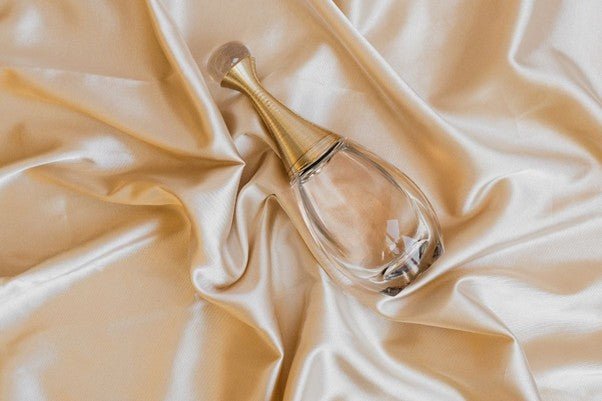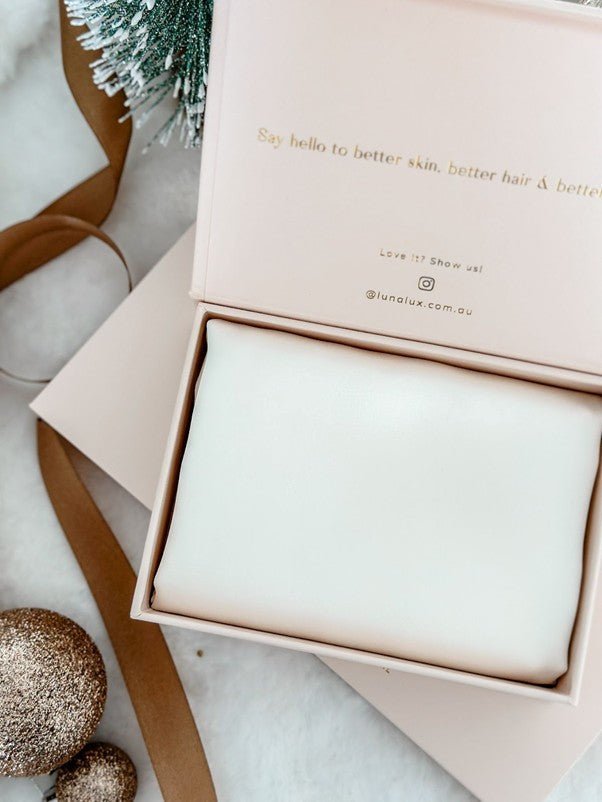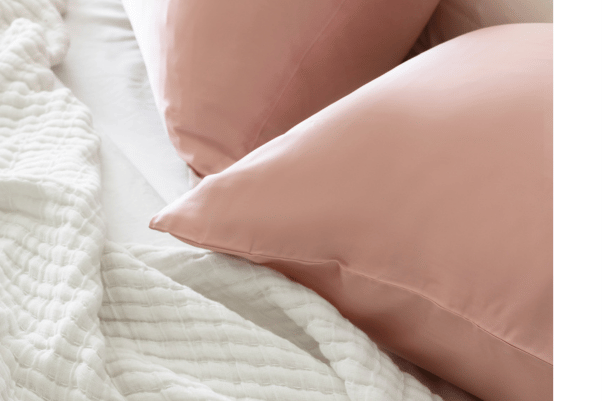Silk is a luxurious fabric that exudes elegance, softness, and sheen. However, besides its aesthetic appeal, silk also holds many health benefits for your skin and hair especially, as it is a natural fibre.
As a natural fibre, silk is more delicate, requiring special care for it to maintain its beauty and benefits. Therefore, anything from silk garments like blouses and dresses to silk accessories such as pillowcases, scrunchies, and eye masks, this natural fibre deserves special care to maintain its quality and beauty.
New to silk or a seasoned collector, understanding proper silk care is essential to prolong its lifespan and preserve its delicate fibres. In this post, we’ll share essential tips for washing, drying, and storing silk items so that you can continue enjoying the beauty and health benefits of your luxurious silk bedding and garments for years to come.
What is Natural Silk and How is It Produced?
Silk is a natural protein-based fibre that is produced by silkworms. Silkworms spin a cocoon that consists of long, continuous threads. Workers harvest the cocoons and clean them, thereafter they then spin the threads into a silk fabric.
The most commonly known and popular natural silk is mulberry silk, which is derived from silkworms that only feed on the leaves of the mulberry tree.
The silk fabric has a renowned lustrous sheen and smooth texture, with a delicate nature thus why it's classified as a luxury item. Silk items also offer a unique combination of aesthetic beauty, comfort, durability and health benefits when it's properly cared for.
Why is it Necessary to Care for Silk?
Silk is a durable fabric, however in contrast is also quite delicate, which means it's easily damaged if not taken care of properly.
The finer silk fibres easily become weakened from improper washing, exposure to chemicals, or high heat. Silk fabrics easily lose their lustre and integrity, as well as their colour becomes dull and brittle if not cared for.
How Silk is Dyed and Its Colourfastness
Because silk absorbs dye differently than synthetic fibres, and other natural fibres, the entire process requires a very delicate balance.
It is essential to properly care for and wash silk to ensure that the colour stays vibrant. Silk garments and products not washed and cared for according to their manufacturer's instructions could bleed dye, causing the fabric colour to fade over time.
Thus, to maintain the vibrancy of your silk products, it is essential to follow instructions, always use cold water for washing, and never dry your silk in direct sunlight.
What are a Few of the Most Popular Silk Products?
Silk is widely used to manufacture a variety of products because of its elegant appeal, soft sheer feeling, and health benefits.
A few popular silk items include:
-
Silk Garments - Silk is often used to manufacture clothing such as nightgowns, sleepwear and underwear. Silk is also used to manufacture a variety of other garments. Silk is temperature regulation and will not overheat. Similarly, it has a soft luxurious feel against your skin.
-
Silk Pillowcases and Bed Linen - Silk bedding especially silk pillowcases, are gentle on the skin and hair, helping to prevent wrinkles and reduce hair breakage. The smooth texture of silk allows for better moisture retention, preventing dry skin and hair.
-
Silk Hair Scrunchies - These prevent hair breakage and reduce the friction that can lead to frizzy, damaged hair. Silk scrunchies are gentle on the hair fibres, allowing you to style your hair without causing harm.
-
Silk Eye Masks - Silk eye masks are perfect for blocking out light, promoting better sleep, and preventing skin irritation around the delicate eye area.
Some silk products are even infused with nourishing ingredients like hyaluronic acid and argan oil, further enhancing the skin and hair benefits. These infused products can provide deep hydration, reduce frizz, and improve the overall health of your skin and hair while you sleep.
How to Properly Care for Silk
Silk is a luxury and delicate fabric that requires proper care and maintenance for it to maintain its beauty and elegance.
Therefore, here are a few tips for caring for your silk items:
Preparation Before Washing
-
Check the Fabric Care Label - Always start by reading the care label on your silk garments. The label provides important information about whether you can wash the silk stem at home, or whether to take it for dry cleaning.
-
Use a Silk-Specific Detergent - Choose a gentle detergent specifically designed for washing silk or delicate fabrics. Harsh chemicals, bleach, and fabric softeners can damage the silk fibres and compromise their integrity.
-
Protect the Fabric with a Mesh Laundry Bag - To protect your silk items from tangling or snagging, place them in a mesh laundry bag before washing. This is especially important if you are machine-washing silk garments.
How to Wash Silk Garments
-
Hand Wash or Machine Wash - Hand washing is generally the safest method for washing silk, however,r if your washing machine has a delicate cycle it should suffice. Keep in mind that the waters should be either cold or lukewarm, but never hot. Use gentle detergents, ideally those specifically made to wash silk with to ensure they do not cause damage. When washing silk in a machine, it's best to use a laundry bag or wash silk items on their own.
-
Cold Water is Key - Ideally, it's best to first soak silk in cold water, and then wash them in cold or lukewarm water to avoid damaging the delicate fibres. Hot or even warmer water could easily cause the silk to shrink, or cause color changes in the fabric.
-
Avoid Overloading the Washing Machine - Essentially you should wash silk on its own or with other silk items. However, when washing silk with other garments just ensure you do not overload the washing machine, as this can cause friction, or use a laundry bag.
Drying and Ironing Silk
-
Lay Flat or Hang Silk Garments - After washing, it’s best to lay your silk garments flat to dry or hang them up. Ensure that you hang the silk items in a shaded area, away from direct sunlight. Excessive exposure to sunlight can cause the colour to fade or the silk to become brittle.
-
Avoid Tumble Drying - Never tumble dry silk as the heat can shrink or damage the delicate silk fibres. Instead, allow the fabric to air dry naturally on a drying rack or by hanging.
-
Iron Silk with Care - Iron silk garments on a low heat setting or silk setting using an ironing board. Always place a clean, white cloth or pressing cloth between the silk and the iron to protect the fabric from heat damage. Never iron silk while it is wet; it should be slightly damp to prevent any burns or watermarks.
Removing Stains and Spills from Silk
-
Spot Treatment - For minor stains or spills use a small amount of cool water and a diluted solution of delicate detergent. Always test the solution on an inconspicuous area of the garment before applying it to the stain.
-
Avoid Scrubbing - Be very gentle when treating stains on silk. Avoid rubbing or scrubbing the fabric, as this can damage the fibres and cause the stain to set deeper into the fabric.
-
Tough Stains - For more stubborn stains, it may be best to seek professional dry cleaning. This is particularly important for delicate items like silk pillowcases, where tough stains may require more expertise to remove without harming the fabric.
Storing Silk Garments
-
Store Silk Properly - When not in use, store your silk garments in a cool, dry place. Avoid hanging them for long periods, as this can cause the fabric to stretch. Instead, fold them neatly and store them in a breathable cotton bag or another fabric bag to ensure adequate air circulation.
-
Protect Against Moths - To protect your silk garments from clothes moths, use moth-repellent sachets or cedar mothballs in your storage area. These will help keep your silk items safe from damage.
-
Avoid Direct Sunlight - When storing silk, keep your garments away from direct sunlight, as prolonged exposure can cause fading and weaken the silk fibres. Store your silk in a dim, cool area.
In Conclusion
Caring for silk garments and accessories requires attention to detail, but the rewards are well worth it. Thus, whether you have silk pillowcases, a lovely silk blouse, or even just a silk hair scrunchie, you must follow the correct care techniques and manufacturer's instructions to ensure your silk items maintain their lustrous beauty and functionality.
Keep in mind, that silk does not tolerate high temperatures, excessive friction, or harsh chemicals, so use caution when washing soil. Store your silk items in a cool dry place to ensure their luxurious feel and longevity.








